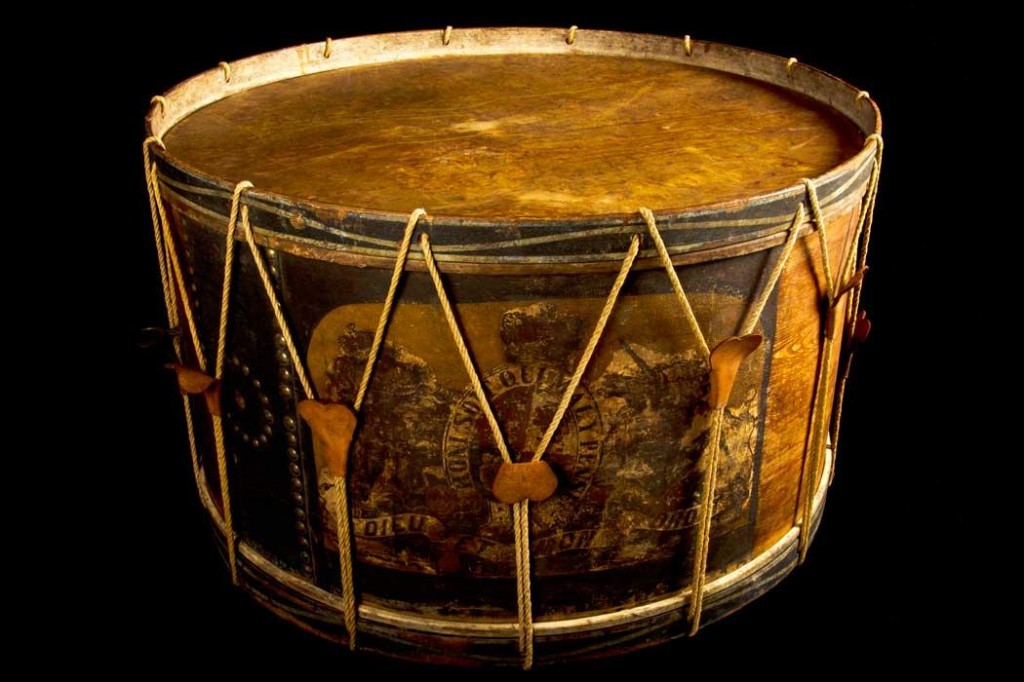Human Drum at Rennes March 18, 2014
Author: Beach Combing | in : Modern , trackback***Thanks to Tokyobling for putting me onto this story and too many others like it***
Had a pretty disturbing week looking at the use of human skins in witchcraft and book covers: things that Beach, in his alloyed innocence, just didn’t realize existed. However, of all the human skin stories I ran across the strangest is some probable cobblers about a man who wanted to become a drum. Let’s start with the few facts that can be reliably hovered up on this subject. In the Nantes Museum of Natural History in lower Brittany there was (notice past tense) a display of tanned human skin. Apparently, Dubuisson, one of the founders of the Museum bought the object for display in 1811. Various online sources, which I have problems trusting entirely, claim that this was the skin of a ‘patriot’ (i.e. a revolutionary) who wanted, on his death, to have his skin made into a drum for the Republican cause. He died in the battle of Nantes in 1793 (where the Republic triumphed over the Royalists) and, in line with his wishes, his body was taken to a tannery where it was discovered that the skin was of insufficient thickness to allow drum-beats: those thin-skinnned revolutionaries… In any case, the now tanned skin (the fate of the body is unknown) then found its way onto the market and from there Dubuisson pounced.
It could be that this was all written under the relevant display in the museum, it could even be true. However, the earliest reference I can find to the drum comes from the 1880s, which is very late. There are too few facts to go around unfortunately: but isn’t that always the way. We can finish, though, with three simple points. First, and most horribly, there is the existence of this skin. Second, there is good documentation for Revolutionary atrocities around Nantes and even the flaying of anti-Republicans: there is, in other words, a good chance that this skin is not of a ‘patriot’ at all but of a Breton royalist… Third, at least until recently, there was the willingness of the museum to display this object. The museum decided, interestingly, to remove the skin after protests by Bretons (some of the grittier of France’s nationalists) at about the same time that the museum sent some decapitated Maori heads back to New Zealand. O tempora! O mores!
There have been counter protests online that these atrocities from the French civil war need to be shown, in the same way, presumably, that human hair is displayed at the Nazis’ killing camps: in which case a Natural History Museum is perhaps not the best place to carry out said showing. I’d contribute a few hard-earned dollars for a museum on Revolutionary attrocities though.
I’ve avoided the photograph because of my queasy stomach. However, if you want to jump into the abyss click away…
Other insights into the evidence for the drum story? drbeachcombing AT yahoo DOT com
At a later date, the human drum of Jan Ziska…
18 March 2014: Lehmansterms writes: I suspect I’ll be carrying a load to Newcastle which is both a day late and a lump short, but if there was some way you could be unaware of the brisk trade – presumably among well-to-do Japanese, possibly former Yakusa themselves – in the tanned, elaborately and, if you like that sort of thing, exquisitely executed full-body tattoo “suits” shuffled-off with the rest of the mortal coil by expiring Yakusa (among whom the consuming pursuit of making one’s entire skin an artistic canvas for the collection of tattoos evidently amounts to no less than a lifelong aspiration in its pursuit and an accumulation of inspirational “honor”), which occasionally become available to the collector-base (this includes cultural museums) for bids, I thought it was worth a torturously long sentence to mention it. Tattoos have a generally odious, antisocial and crime-linked historic significance in Japan, so the Yakusa who dares to cover every non-publicly displayed square inch of skin in the elaborate, traditional manner – which does not include modern electric tattoo needles, rather “combs” of sharpened bamboo and porcupine quills, etc, which are expertly – and by all accounts excruciatingly – jabbed into the skin by the very few practitioners of this art form – acquires, ironically, great “face” among those who might even be aware of what is in polite society traditionally an un-displayable body decoration and kept covered-up at all times in public. Although, as with so many traditions, this is no longer so assiduously frowned-upon among those to whom it would have been anathema a generation ago, public display of tattoos on one’s body is generally considered to be in poor taste, at least. I am told a visible tattoo could still be reason enough for a person to be considered conventionally unemployable. Lampshades? Unfortunately that’s in the minor leagues of the game. This is a far more completely macabre phenomenon, long enshrined in cultural tradition, rather than a fleeting aberration. Thanks L!



